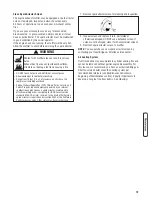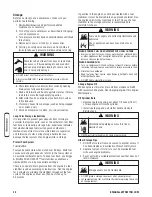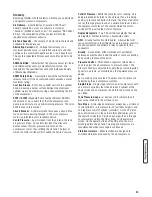
10
BRIGGSandSTRATTON.COM
Operation
If you have any problems with operation of your air
compressor, call air compressor helpline at
(800) 743-4115
.
If calling for assistance, please have the model, revision, and
serial number from the data tag available.
Air Compressor Operating Location
Clearances and Air Movement
Place air compressor outdoors in an area that will not
accumulate deadly exhaust gas. DO NOT place air
compressor where exhaust gas (
A
) could accumulate and
enter inside or be drawn into a potentially occupied building.
Ensure exhaust gas is kept away from any windows, doors,
ventilation intakes, or other openings that can allow exhaust
gas to collect in a confined area. Prevailing winds and air
currents should be taken into consideration when positioning
air compressor.
The air compressor pump is designed to allow for proper
cooling. The ventilation openings on the compressor are
necessary to maintain proper operating temperature. DO
NOT place rags or containers on or near these openings.
Keep the air filter clear of obstructions that could reduce
airflow to the air compressor.
Operate the air compressor with unit located on a flat surface
to ensure that it receives proper lubrication.
Break-In Procedure
Before first use of this equipment, the system must undergo
a break-in operation, as described in this section.
1. Open both drain valves (rotate fully counterclockwise)
to prevent air pressure build-up in air tank during
break-in period.
NOTE
: Always drain air tank over a washable surface or in a
suitable container to prevent damaging or staining surfaces.
2. Start your air compressor following steps 1 through 7
in the section
Starting Your Air Compressor
.
3. Run compressor for 15 minutes. Make sure start valve
and drain valves remain open.
4. After 15 minutes, with air compressor running, close
start valve (flip pin down to a horizontal position) and
both drain valves (rotate fully clockwise). Air tanks will
fill to “cut-out” pressure and engine speed will slow to
idle.
NOTE:
If you hear leaking air, pull quick connect coupler
back until it clicks to reset coupler valve.
5. Turn your air compressor off as described in
Stopping
Your Air Compressor
.
NOTE:
Check oil level in compressor after break-in.
The compressor has completed the break-in procedure and
is ready for normal use.
NOTICE
Serious damage may result if the break-in instructions are
not closely followed.
• This procedure is required before the air compressor is put into
service and when the check valve or a complete compressor
pump has been replaced.
WARNING
Exhaust heat / gases can ignite combustibles,
structures or damage fuel tank causing a fire.
• Keep at least 5 ft. (1.5 m) clearance on all sides of air
compressor including overhead.
A
WARNING
Running engine gives off carbon monoxide, an
odorless, colorless, poison gas.
Breathing carbon monoxide can cause headache,
fatigue, dizziness, vomiting, confusion, seizures,
nausea, fainting or death.
• Operate air compressor ONLY outdoors.
• Keep exhaust gas from entering a confined area through
windows, doors, ventilation intakes, or other openings.
• DO NOT start or run engine indoors or in an enclosed area, even
if windows and doors are open.











































